Colour in the winter garden
In the wild they thrive in conditions described as arid and impoverished, growing where most other plants would not survive. Therefore, to grow these plants in the Proteaceae family, you must try to emulate similar conditions and not lavish attention upon them! Full sun and perfectly free-draining soil are a must.
Planting in autumn through to spring when the soil is moist will give the shrubs time to establish before summer. Don’t fertilise, except occasionally with slow release acidic food, and water well the first year. Once established, they require little watering and will tolerate most frosts. You can practically leave them to their own devices!
Proteas
No flower is more striking than the protea. These robust garden shrubs display stunning flowers for picking or simply admiring in your garden, mainly through the late winter and spring months. They are salt tolerant, so are perfect for coastal gardens. They’re also wonderful plants for attracting native birds such as tui and bellbird.
Prune young plants in spring to create a strong bush. Cutting flowers for the vase is a great way to prune but also remove spent flowers. Look for these popular varieties:
- P. cynaroides – King Protea – soft pale pink flowerheads up to 300mm in diameter. Grows to 3x1.5m
- P. cynaroides ‘Arctic Ice’- is a white King Protea, frost hardy once established. 2x2.5m
- P. nerifolia Alba – creamy-yellow flower heads. 3x2.5m
- 'Pink Ice' - deep rose pink flowers. The hardiest of all proteas. 2x2m
- ‘Red Ice’ – red flowers almost all year round. 2.5x2.5m
Leucadendrons
Leucadendrons are very easy care. They grow abundant flowers which colour up with winter’s chill. They are inclined to become leggy, so you simply have to pick them! Pick long stems for the vase each year to encourage your plants to become bushy and not taller and taller. Popular varieties include:
- Amy – abundant creamy yellow flowers flushed with red. 1.5x1m
- Copper Tone – coppery gold flowers late winter to spring. 2x1.5m
- Fireglow – deep red flower bracts late summer & early autumn. 1.2x1m
- Inca Gold – brilliant yellow flowers with red edges. 1.8x1.5m
- Safari Sunset - raised in NZ. Long stems of wine red flowers. 2.5x1.5m
Leucospermums
Leucospermums are recognised for their striking and exotic pincushion flowers, brilliantly coloured in red, orange and yellow from spring to early summer. They will not survive in rich soil so should not be fertilised but regular watering during warm dry weather is beneficial. They are perfect for coastal gardens, enjoying the free-draining soils and tolerant of salt-laden winds. Look for:
- High Gold – bright yellow flowers. 1.5x1.5m
- Lani – soft orange-red flowers. 2x2m
- Maui Magic – prolific champagne pink flowers. 1.5x2m
- Scarlet Ribbons – scarlet and orange flowers. 2x2m
Grevilleas
The range of Grevilleas is huge, not only in colour and flower form but also in their habit and use, from ground covering and small shrubs to tall shelter and shade trees. Some varieties flower throughout the year, but Grevilleas are mainly enjoyed through winter when their bright flowers are conspicuous. All contain nectar, attracting bees and native birds.
Grevilleas are very easy to grow. Trim them regularly in the warmer months to encourage quick new growth and re-flowering. They all love full sun and long periods without rain will not trouble them. Look for…
- Bronze Rambler - a groundcover with bronze-coloured new foliage and wine red ‘toothbrush’ flowers. It is perfect for densely covering ground and trailing over banks and walls. Approximately 20cm high and spreads to 1.2m.
- New Blood - a groundcover with fresh green foliage startling deep red ‘spider’ flowers (year-round) that birds love. Approximately 25cmx1.5m.
- Fireworks - a small shrub with striking bright red & yellow 'spider' flowers. Approximately 1mx75cm.
- Knockout - a small tough shrub with an amazing display of orange/yellow 'spider' flowers in spring and summer. Approximately 1x1m.
- Superb - a large shapely shrub that also makes a good hedge. Large orange-red 'toothbrush' flowers attract nectar feeding birds. Approximately 2x2m.
- Robin Hood is often regarded as the best Grevillea. This small tree grows to 3m tall by 2m wide, and flaunts 10cm scarlet ‘toothbrush’ flowers from spring through summer. Its nectar rich flowers attract tui, bellbirds and wax eyes.
Unusual jewels of Africa
Phylica pubescens (Flannel Flower) is a small shrub with the softest feathery foliage and flowers that you will want to run your fingers through. The creamy white flowers appear in autumn and winter and are perfect for the vase and drying. They grow easily in dry and coastal conditions. Grows 1.8x1.5m
Aulax cancellata (Featherbush) features deep bronze-coloured needle-like foliage in autumn and winter and unusual feathery yellow flowers spring and summer. Grows 2x1.5m.

15-Jun-2023

King protea Arctic Ice

Protea Pink Ice
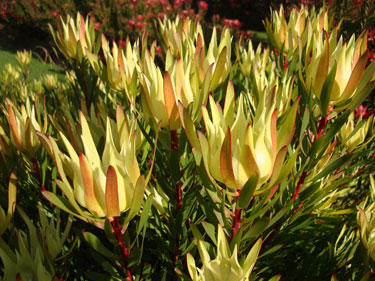
Leucadendron Inca Gold
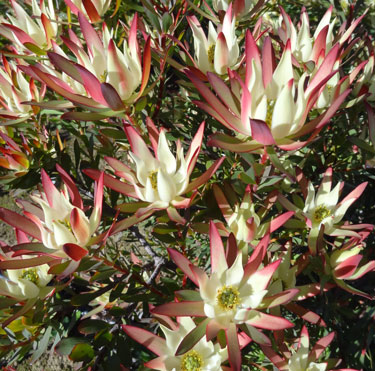
Leucadendron Amy
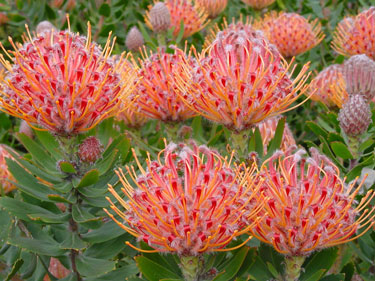
Leucospermum Scarlet Ribbons
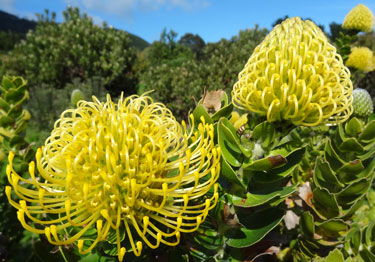
Leucospermum High Gold
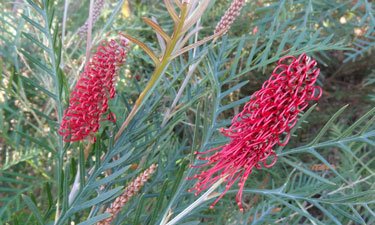
Grevillea Robin Hood
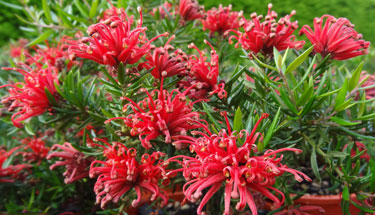
Grevillea New Blood
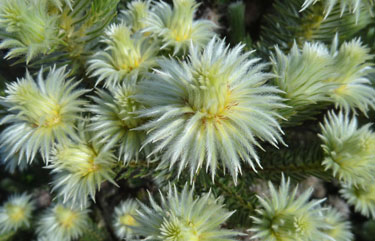
Phylica pubescens
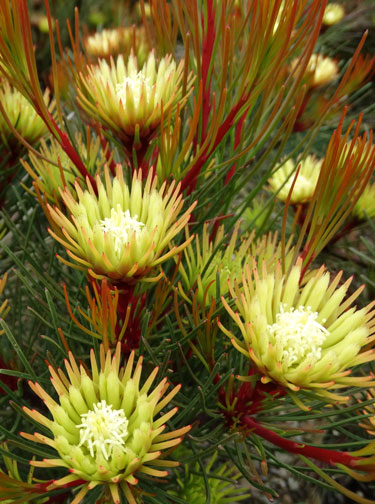
Aulax cancellata

